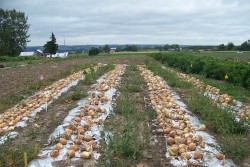Stop the Rot! - Using Cultural Practices to Manage Bacterial Diseases of Onion
Christy Hoepting, Extension Vegetable Specialist
Cornell Vegetable Program

Do you know how easy this is? A simple modification to adjust your planting configuration is all it would take to drastically reduce losses from bacterial bulb decay. Our studies showed that when plant spacing was reduced from 6 or 8 inches to 4 inches with 3 or 4 rows per 3-foot plastic mulch bed (row spacing: 4 rows = 6 inch; 3 rows = 8 inch), this provided 53 to 64% control of bacterial bulb decay at harvest (Table 1). Marketable yield also increased by 1.4 to 2.4 times, representing an increased net economic return of $43 to $258 per 100 feet of bed, due to increased weight of marketable jumbo-sized bulbs (Table 1). We learned that wide plant spacing produces big bushy plants with more leaves, thicker necks, delayed maturity and bigger bulbs. Unfortunately, it was these bigger bulbs that rotted! By narrowing plant spacing, we got fewer colossal-sized bulbs, which we more than made up for by having significantly more healthy jumbo-sized bulbs to market (Table 1).
Alternatives to black plastic reduced bacterial bulb decay by 59 to 75%
This is also a very simple and easy modification for small-scale growers producing onions on plastic mulch to make to their cultural practices that could go a very long way towards reducing bacterial bulb decay. Our studies showed that reflective silver mulch, biodegradable black plastic and bare ground had significantly 1.8 to 2.8 times higher marketable yield than black plastic (Table 2). Reflective silver and biodegradable black plastics had significantly 3.7 and 3.6 times, respectively, higher jumbo weight than black plastic, which resulted in an increased net return of $96 to $215 per 100 feet of bed compared to black plastic (Table 2). All of the alternatives to black plastic had significantly lower soil temperatures compared to the black plastic; we suspect that the higher temperatures of the black plastic are more favorable for development of bacterial diseases.
Stop the Rot article (pdf; 1356KB)

Upcoming Events
Vegetable Pest and Cultural Management Field Meeting for Auction Growers -- Ontario Produce Auction
July 15, 2025
Stanley, NY
This evening meeting will demonstrate pest management in fresh market vegetables in both field and greenhouse (high tunnel) vegetables, primarily for those growing for wholesale auction. A hands-on demonstration of weed, insect and disease identification in vegetables including management options. Details on each topic will focus on field observations at the farm.
Orleans Summer Vegetable Meeting, 2025
July 16, 2025
Waterport, NY
Meeting themes are pest management in a wide array of produce and best practices for pesticide use. Professor Brian Nault will cover allium leaf miner and thrips in onions, garlic, and leeks, and discuss insect challenges in other crops. Bring your questions! We'll also have a field walk that includes high tunnel tomato and cucumber.
DEC credits available: 0.5 in CORE plus either 1.25 in 1a and 23, or 0.75 in 24.
Vegetable Pest and Cultural Management Field Meeting for Auction Growers -- Finger Lakes Produce Auction
July 18, 2025
Penn Yan, NY
This evening meeting will demonstrate pest management in fresh market vegetables in both field and greenhouse (high tunnel) vegetables, primarily for those growing for wholesale auction. A hands-on demonstration of weed, insect and disease identification in vegetables including management options. Details on each topic will focus on field observations at the farm.


































